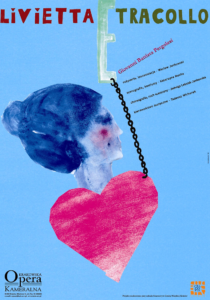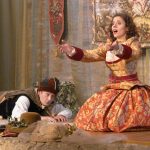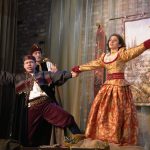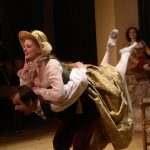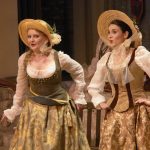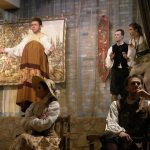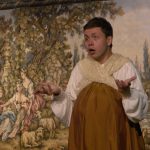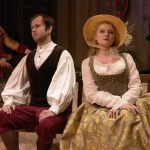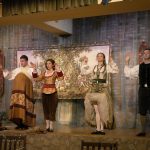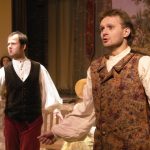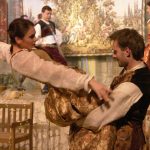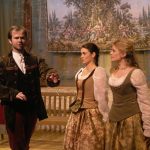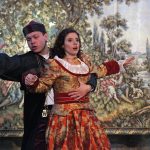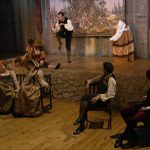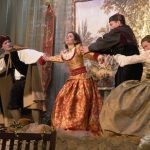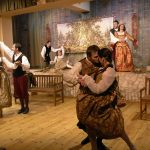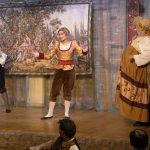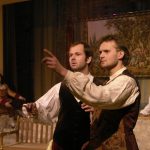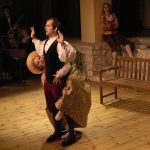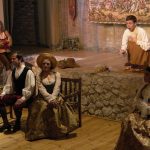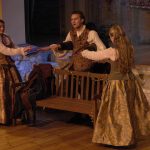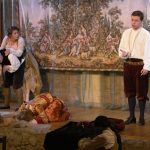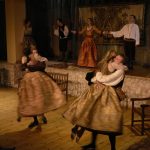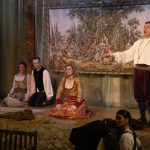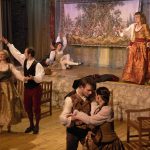Credits
Staging and direction: Wacław Jankowski
Musical direction, conductor: Michał Łukasz Niżyński
Scenography, costumes: Katarzyna Mucha
Choreography, stage movement: Jadwiga Leśniak-Jankowska
Livietta
Anna Koźlakiewicz (soprano)
Martyna Malcharek
Anna Warchał
Tracollo
Viktor Yankowskyi (baryton)
Kamil Joński
Maciej Rutkowski
Fulvia
Jadwiga Zechenter
Facenda
Piotr Malaga
The Krakow Chamber Opera Orchestra:
Skrzypce I: Artur Łuczak
Skrzypce II: Aleksandra Gawlik
Altówka: Kinga Szczepanik-Suchoń
Wiolonczela: Karolina Kalinowska
Kontrabas: Lesław Wydrzyński
Klawesyn: Katarzyna Starzycka
Photos
fot.P.Zechenter
fot.A.Łoboda
Reviews
(…) Krakow Chamber Opera, which specializes in chamber music rarities, has decided to stage Pergolesi’s comic opera – it was the first time it has been performed in Krakow. As always, they have done it with great care and a sense of style – all the cogs of this musical trifle have been tweaked with great accuracy. The most fitting and particularly refreshing idea seems the addition of four actors alongside the eponymous singing characters and their counterparts of sorts – the silent companions, Fulve and Faccenda. Those extra performers serve as the ‘tongues’ of the protagonists, declaiming recitativo secco in Polish (excellent translation by Joanna Kulmowa). The sung parts are therefore performed in their original, Italian version. The recitatives, however, do not lose any of the musical quality due to their rhythmic pattern, unisono declamation or the echo effect. Their dramatic and comic accuracy certainly gain a lot from this approach. The verbal, onomatopeic and choreographic acrobatics frolicing with Mariani’s mediocre and well-worn lines are undoubtedly one of the spectacle’s highlights. The basic tone of the comic performance: the ambivalence, that is the clashing of effervescence with infatuatiuon, is brilliantly brought out. Let me just mention the scene where Livietta ‘bounds’ the imprisoned Tracollo with her own legs.
The actors who deserve most praise were Magdalena Kajrowicz and Paweł Kumięga (Livietta and Tracollo) as well as Piotr Malaga, a mime playing Faccenda. My compliments also go out to the musicians: Tadeusz Wicherek for the precise conducting of an instrumental sextet; Valentina Pennino – a half German, half Italian soprano with a highly sophisticated voice; bass/baritone Artur Rożek for his subtle timbre. The stylish costumes prepared by Katarzyna Mucha – rustical, courtly and fantastic – have yet again proven the great taste of their author. They were complemented by the main element of scenography – a painting depicting an idyllic scene.
Charles de Brosses wrote in 1740 after seeing some intermezzo in Rome: ‘Those fools weep, roar with laughter, throw themselves around, indulge in all manners of pantomime and never lose their pace, not even for one-eighth of a second.’ The Krakow staging would probably move him to put down similar remarks. After all, the creative minds behind this spectacle strive for perfection. They have decided to go back to the origins of opera buffa, that is commedia dell’arte. In doing so they have clearly not forgotten that ‘arte’ not only means ‘art’, but also ‘skill’. Because there can be no ‘art’ without a ‘trick’. Why are so many people forgetting about this?
Monika Partyk
‘Ruch Muzyczny’
Issue 13, 22nd June 2008
* * * * * * * *
Ladies and Gentlemen,
Once again, I would like to express my gratitude for the invitation to the Sunday’s spectacle. I would also like to share some of my opinions on the performance, even more so because I was so impressed by it. It was a marvellous idea to add another set of performers and introduce a purely theatrical layer of the play. Taking aside the obvious benefit of making libretto more meaningful by including its Polish version (and an excellent translation, too), the theatrical part significantly enriched the whole spectacle. Its form has grown from a short intermezzo to a full-blown, musical and theatrical show – or rather the other way round, since to me the theatrical layer was dominant the whole time.
The directing of the theatrical parts seemed just perfect to me. It was brilliantly rhytmical, vivid, and, what appealed to me the most, very Mozartian – at times breaking with the buffo convention and the clowning of commedia dell’arte by very subtly, yet clearly underlining more serious, deeper meanings. The two actors playing Tracollo did a wonderful job – the most compelling moments of the show were those in which they seemingly remained in the light, comedic mood, but actually hit on a more sombre tone (death, parting). That is what I have in mind when I write about the ‘Mozartian’ way of directing. Breaking up with the convention, reaching past it non-ostentatiously, but clearly enough – all of this has been accomplished in these several scenes. Those are the qualities which have been so brilliantly exhibited in the best of Mozart’s operas. It means keeping the balance between buffo and non-buffo, while making sure the non-buffo part is not too serious – there is some ambiguity and understatement to it.
I am fully aware that I may sound a bit vague here, but the thing I am trying to describe here probably defies any description – it is a musical, non-verbal phenomenon. Either way, I have sensed a distinct trace of such ‘Mozartian’ thinking on theatre, both in the director’s concept as well as in the performance of actors and actresses.
I found the spectacle as a whole to be very rewarding, I have already recommended it to all of my friends in Krakow.
Conductor of Warsaw Chamber Opera
Przemysław Fiugajski
* * * * * * * *
In the opera ‘Livietta e Traccolo’ directed by Wacław Jankowski everything has been precise and painstakingly perfect – not a single thing was left unattended. The spectacle has been staged by Krakow Chamber Opera as a part of their project which aims to regain the obscure chamber pieces for the Polish audiences. Everything in this staging seemed like a well-proportioned recipe brought to life: the two amazing singers (Magdalena Rucińska and Artur Rożek) perfectly fitted for their roles, a pair of excellent mimes and finally a quartet of actors who delivered the Polish, recited version of the original libretto. The choreographic elements in the vein of commedia dell’arte was also interesting – universal stage design has been enriched by the elegant costumes created by Katarzyna Mucha. The music ensemble directed by Tadeusz Wicherek has provided us with an hour of pure delight.
Gabriella Buzzi
SIPARIO, January 2009
* * * * * * * *
An opera about a false Polish Woman
The Krakow Chamber Opera has performed for the third time in our town. This time the troupe has performed ‘Livietta e Tracollo’ by Giovanni Battista Pergolesi in the local ‘Rabcio’ theatre. The spectacle has had its premiere in Naples in 1734. It is the so-called opera buffa, based on a witty libretto by Tommaso Mariani – it employs numerous tropes derived from comedy of errors as well as lots of dress-ups.
The story centers on a clever petty thief Tracollo – he robs the house of Livietta’s cousin while dressed up as a Polish pregnant beggar woman. Livietta swears revenge on the robber, not knowing that he is in fact her new love interest. The staging ideas of director Wacław Jankowski and choreography by Jadwiga Leśniak-Jankowska managed to convert a group of singers into an excellent group of comedians. They even succedeed in incorporating elements of ballet into the show. What is more, every performer has been given a doppelganger, which populated the stage a bit. Thanks to that clever maneuver we have been given a particularly dynamic spectacle, at times even modernized and thus better suited for our contemporary sense of humour. Splitting the spoken parts in Polish from the sung ones in Italian has been a particularly ingenious solution as well. It certainly helped with keeping track of the numerous plot twists. On the other hand, some tribute has been paid to the tradition – the accompaniment has been provided by a small ensemble playing on replicas of historical instruments (baroque violin, traverso flute, viola da gamba, double bass and spinet). This unusual blend of both old and modern interpretative means turned out to create a surprisingly successful, homogenous unity. Thus the spectacle has been well received by the audience, who awarded it with a round of applause.
Rabka-Zdrój, 20th July 2009
Official town’s website
The spectacle has been staged as a part of festive congress and conference of partner towns: Murrhardt, Chateau-Gontier, Fromme and Rabka Zdrój.

